Coursework-1 Collaborative Activity Assignment PDF
VerifiedAdded on 2021/02/05
|11
|2130
|53
AI Summary
Contribute Materials
Your contribution can guide someone’s learning journey. Share your
documents today.

Coursework-1
Collaborative Activity
Yasir Mirza
100491438
4BM502- Management Theory and Practice
University of Derby
[Instructor’s name]
July 6, 2019
Collaborative Activity
Yasir Mirza
100491438
4BM502- Management Theory and Practice
University of Derby
[Instructor’s name]
July 6, 2019
Secure Best Marks with AI Grader
Need help grading? Try our AI Grader for instant feedback on your assignments.
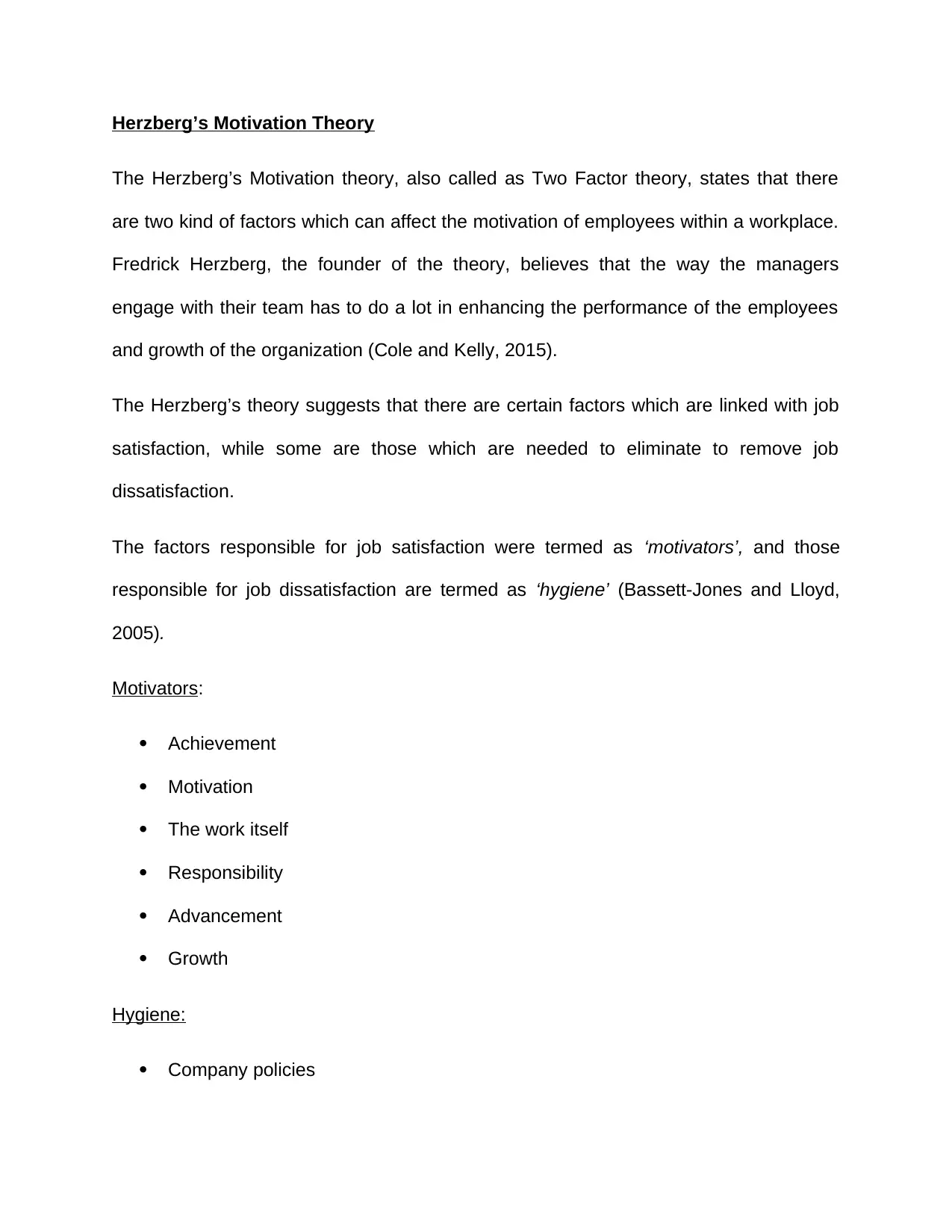
Herzberg’s Motivation Theory
The Herzberg’s Motivation theory, also called as Two Factor theory, states that there
are two kind of factors which can affect the motivation of employees within a workplace.
Fredrick Herzberg, the founder of the theory, believes that the way the managers
engage with their team has to do a lot in enhancing the performance of the employees
and growth of the organization (Cole and Kelly, 2015).
The Herzberg’s theory suggests that there are certain factors which are linked with job
satisfaction, while some are those which are needed to eliminate to remove job
dissatisfaction.
The factors responsible for job satisfaction were termed as ‘motivators’, and those
responsible for job dissatisfaction are termed as ‘hygiene’ (Bassett-Jones and Lloyd,
2005).
Motivators:
Achievement
Motivation
The work itself
Responsibility
Advancement
Growth
Hygiene:
Company policies
The Herzberg’s Motivation theory, also called as Two Factor theory, states that there
are two kind of factors which can affect the motivation of employees within a workplace.
Fredrick Herzberg, the founder of the theory, believes that the way the managers
engage with their team has to do a lot in enhancing the performance of the employees
and growth of the organization (Cole and Kelly, 2015).
The Herzberg’s theory suggests that there are certain factors which are linked with job
satisfaction, while some are those which are needed to eliminate to remove job
dissatisfaction.
The factors responsible for job satisfaction were termed as ‘motivators’, and those
responsible for job dissatisfaction are termed as ‘hygiene’ (Bassett-Jones and Lloyd,
2005).
Motivators:
Achievement
Motivation
The work itself
Responsibility
Advancement
Growth
Hygiene:
Company policies

Supervision
Relationship with supervisor and peers
Work conditions
Salary
Status
Security
According to Herzberg, the factors leading to satisfaction and dissatisfaction have
nothing to do with each other. Hence even if managers carefully consider hygiene
factors they may achieve peace in workplace but not necessarily achieve best
performance from the employees without presence of motivators (Yosuff et al, 2013).
How far can this theory explain situations with which you are familiar?
In my consciousness, I found it working positively in a case of my friend. My friend once
had an experience of working in an advertising firm. He was receiving a good salary
package, with job security and nice working environment. However, he was
experiencing dullness and lack of motivation to work. With a change in managerial staff,
his motivation was regained. The reason being, the new managerial staff allowed to
employees to be autonomous in their dedicated task with minimum dictatorship. They
put responsibility on the employees which led them to work with more energy and
bringing up their talent to next level.
Herzberg’s Theory in context of two other theories
Maslow’s theory of motivation is a hierarchical theory which defines the elements of
satisfaction/ motivation from lower to higher order (Dinibutun, 2012). If Herzberg’s
Relationship with supervisor and peers
Work conditions
Salary
Status
Security
According to Herzberg, the factors leading to satisfaction and dissatisfaction have
nothing to do with each other. Hence even if managers carefully consider hygiene
factors they may achieve peace in workplace but not necessarily achieve best
performance from the employees without presence of motivators (Yosuff et al, 2013).
How far can this theory explain situations with which you are familiar?
In my consciousness, I found it working positively in a case of my friend. My friend once
had an experience of working in an advertising firm. He was receiving a good salary
package, with job security and nice working environment. However, he was
experiencing dullness and lack of motivation to work. With a change in managerial staff,
his motivation was regained. The reason being, the new managerial staff allowed to
employees to be autonomous in their dedicated task with minimum dictatorship. They
put responsibility on the employees which led them to work with more energy and
bringing up their talent to next level.
Herzberg’s Theory in context of two other theories
Maslow’s theory of motivation is a hierarchical theory which defines the elements of
satisfaction/ motivation from lower to higher order (Dinibutun, 2012). If Herzberg’s

theory is studied in light of Maslow’s model of motivation, it is figured out that the
motivators in Herzberg’s theory are similar to the higher order elements in Maslow’s
theory, i.e. self-actualization and esteem. While the hygiene factors reflect the lower
order needs, i.e. social and physiological needs. The later factors are considered
extrinsic in Herzberg theory while Maslow’s theory suggests that these are intrinsic
similar to higher order needs.
Another motivation theory by David McClelland, called Needs Theory of Motivation
relies of three basic needs: need for power, need for achievement and need for
affiliation. Observing Herzberg’s theory and McClelland’s theory closely. The first two
needs coincides with motivators: responsibility and achievement, while the third one
reflects the hygiene factor: relationship with supervisors and peers. It suggests that the
motivation theories have close ties with each other, the only difference is that some
factors are considered intrinsic or extrinsic by different theorists with different priorities
(Yosuff et al, 2013).
Word count: 499
References:
Bassett-Jones, N., Lloyd, G. C. (2005), Does Herzberg’s motivation theory have staying
power?, Herzberg’s Motivation Theory, Journal of management development, 24(10)
pp. 929-943, Emeraldinsight, [Online], Available at: https://www-emeraldinsight-
motivators in Herzberg’s theory are similar to the higher order elements in Maslow’s
theory, i.e. self-actualization and esteem. While the hygiene factors reflect the lower
order needs, i.e. social and physiological needs. The later factors are considered
extrinsic in Herzberg theory while Maslow’s theory suggests that these are intrinsic
similar to higher order needs.
Another motivation theory by David McClelland, called Needs Theory of Motivation
relies of three basic needs: need for power, need for achievement and need for
affiliation. Observing Herzberg’s theory and McClelland’s theory closely. The first two
needs coincides with motivators: responsibility and achievement, while the third one
reflects the hygiene factor: relationship with supervisors and peers. It suggests that the
motivation theories have close ties with each other, the only difference is that some
factors are considered intrinsic or extrinsic by different theorists with different priorities
(Yosuff et al, 2013).
Word count: 499
References:
Bassett-Jones, N., Lloyd, G. C. (2005), Does Herzberg’s motivation theory have staying
power?, Herzberg’s Motivation Theory, Journal of management development, 24(10)
pp. 929-943, Emeraldinsight, [Online], Available at: https://www-emeraldinsight-
Secure Best Marks with AI Grader
Need help grading? Try our AI Grader for instant feedback on your assignments.
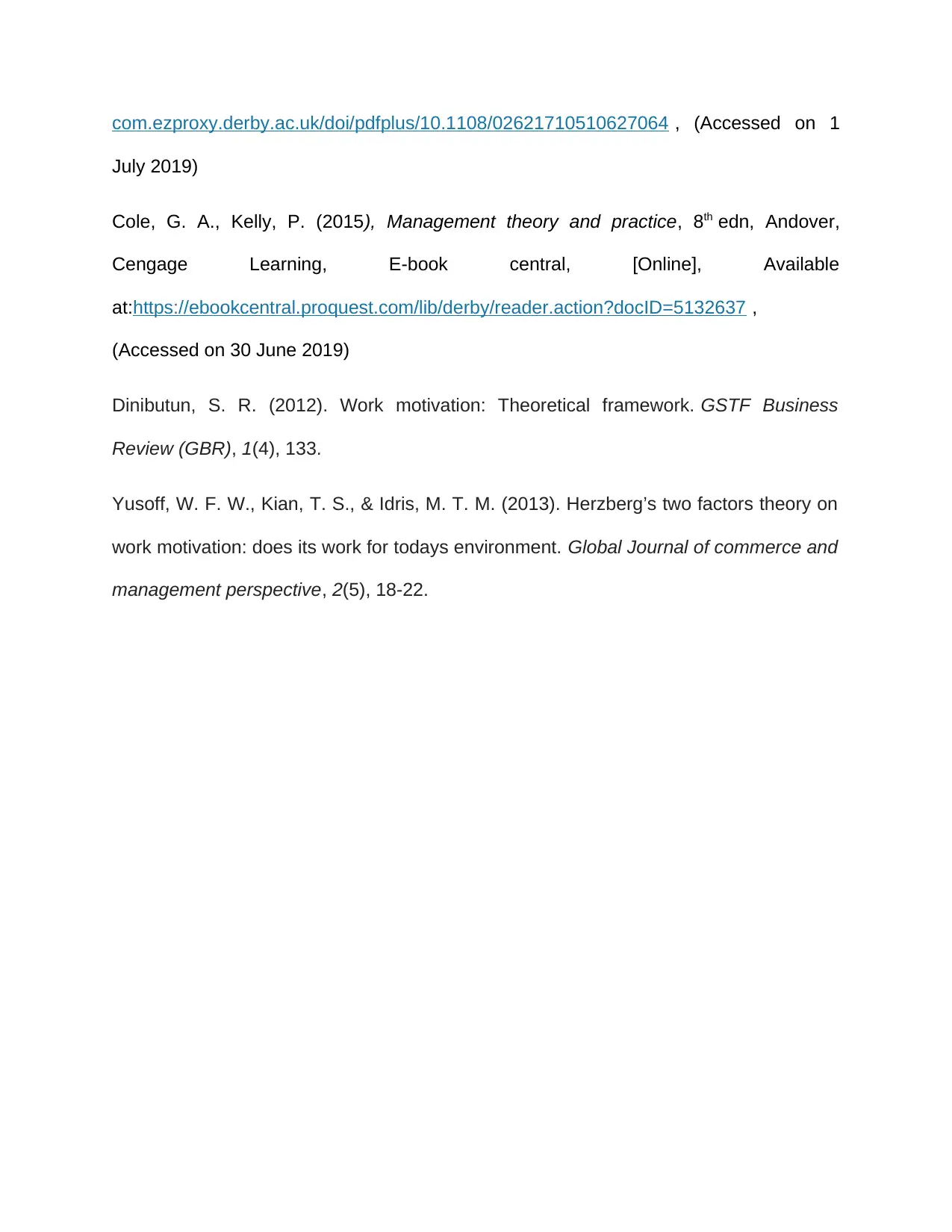
com.ezproxy.derby.ac.uk/doi/pdfplus/10.1108/02621710510627064 , (Accessed on 1
July 2019)
Cole, G. A., Kelly, P. (2015), Management theory and practice, 8th edn, Andover,
Cengage Learning, E-book central, [Online], Available
at:https://ebookcentral.proquest.com/lib/derby/reader.action?docID=5132637 ,
(Accessed on 30 June 2019)
Dinibutun, S. R. (2012). Work motivation: Theoretical framework. GSTF Business
Review (GBR), 1(4), 133.
Yusoff, W. F. W., Kian, T. S., & Idris, M. T. M. (2013). Herzberg’s two factors theory on
work motivation: does its work for todays environment. Global Journal of commerce and
management perspective, 2(5), 18-22.
July 2019)
Cole, G. A., Kelly, P. (2015), Management theory and practice, 8th edn, Andover,
Cengage Learning, E-book central, [Online], Available
at:https://ebookcentral.proquest.com/lib/derby/reader.action?docID=5132637 ,
(Accessed on 30 June 2019)
Dinibutun, S. R. (2012). Work motivation: Theoretical framework. GSTF Business
Review (GBR), 1(4), 133.
Yusoff, W. F. W., Kian, T. S., & Idris, M. T. M. (2013). Herzberg’s two factors theory on
work motivation: does its work for todays environment. Global Journal of commerce and
management perspective, 2(5), 18-22.
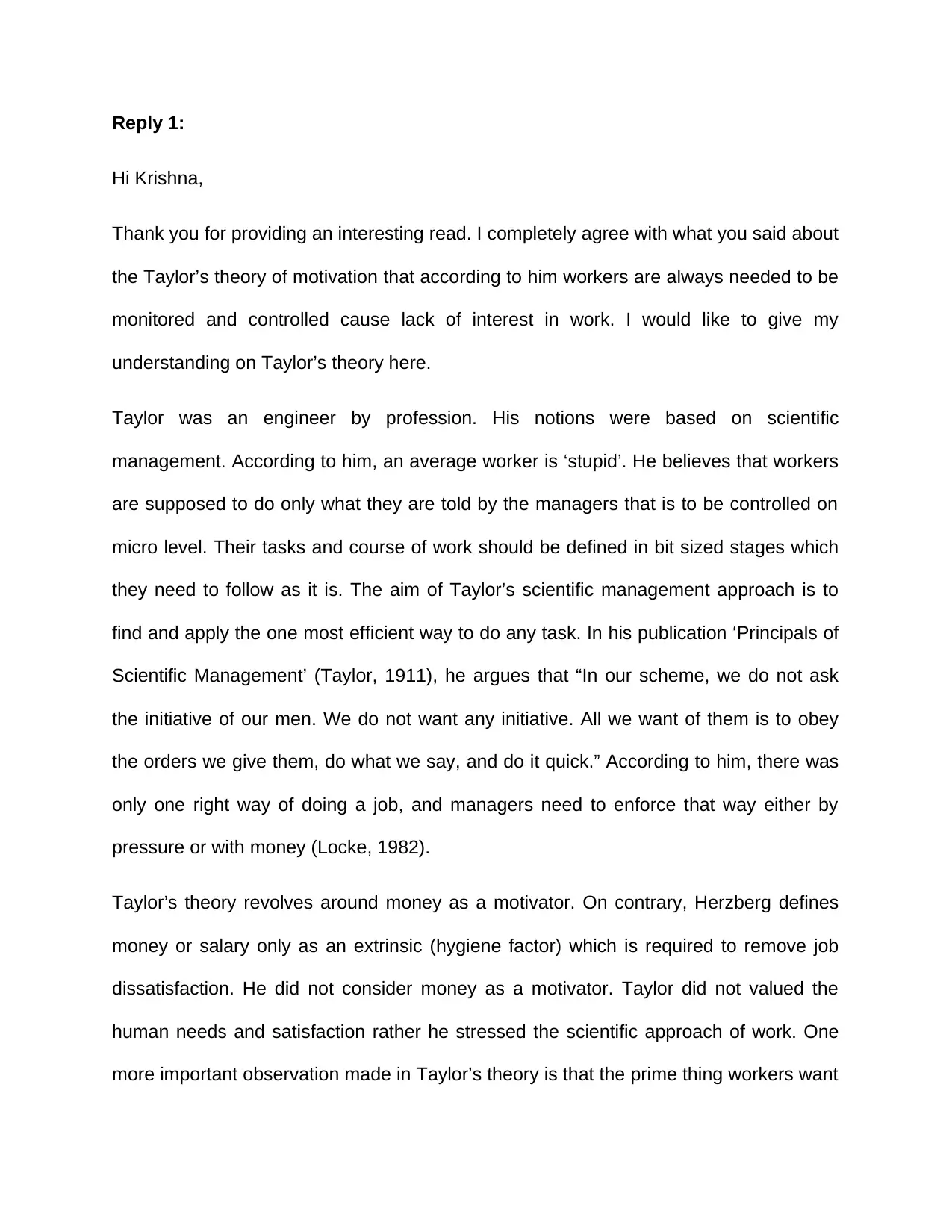
Reply 1:
Hi Krishna,
Thank you for providing an interesting read. I completely agree with what you said about
the Taylor’s theory of motivation that according to him workers are always needed to be
monitored and controlled cause lack of interest in work. I would like to give my
understanding on Taylor’s theory here.
Taylor was an engineer by profession. His notions were based on scientific
management. According to him, an average worker is ‘stupid’. He believes that workers
are supposed to do only what they are told by the managers that is to be controlled on
micro level. Their tasks and course of work should be defined in bit sized stages which
they need to follow as it is. The aim of Taylor’s scientific management approach is to
find and apply the one most efficient way to do any task. In his publication ‘Principals of
Scientific Management’ (Taylor, 1911), he argues that “In our scheme, we do not ask
the initiative of our men. We do not want any initiative. All we want of them is to obey
the orders we give them, do what we say, and do it quick.” According to him, there was
only one right way of doing a job, and managers need to enforce that way either by
pressure or with money (Locke, 1982).
Taylor’s theory revolves around money as a motivator. On contrary, Herzberg defines
money or salary only as an extrinsic (hygiene factor) which is required to remove job
dissatisfaction. He did not consider money as a motivator. Taylor did not valued the
human needs and satisfaction rather he stressed the scientific approach of work. One
more important observation made in Taylor’s theory is that the prime thing workers want
Hi Krishna,
Thank you for providing an interesting read. I completely agree with what you said about
the Taylor’s theory of motivation that according to him workers are always needed to be
monitored and controlled cause lack of interest in work. I would like to give my
understanding on Taylor’s theory here.
Taylor was an engineer by profession. His notions were based on scientific
management. According to him, an average worker is ‘stupid’. He believes that workers
are supposed to do only what they are told by the managers that is to be controlled on
micro level. Their tasks and course of work should be defined in bit sized stages which
they need to follow as it is. The aim of Taylor’s scientific management approach is to
find and apply the one most efficient way to do any task. In his publication ‘Principals of
Scientific Management’ (Taylor, 1911), he argues that “In our scheme, we do not ask
the initiative of our men. We do not want any initiative. All we want of them is to obey
the orders we give them, do what we say, and do it quick.” According to him, there was
only one right way of doing a job, and managers need to enforce that way either by
pressure or with money (Locke, 1982).
Taylor’s theory revolves around money as a motivator. On contrary, Herzberg defines
money or salary only as an extrinsic (hygiene factor) which is required to remove job
dissatisfaction. He did not consider money as a motivator. Taylor did not valued the
human needs and satisfaction rather he stressed the scientific approach of work. One
more important observation made in Taylor’s theory is that the prime thing workers want

from their employers is money, and the employers want from the workers is low labor
costs. Thus it is required to set a compatibility in terms of wages where workers do the
given tasks correctly, consistently and within time limits (Spender and Kijne, 2012).
This was my study about Taylor’s theory of motivation based on scientific management,
hope it adds some worthy pieces to your great knowledge.
Word count: 353
References:
Taylor, F. W. (1911). The principles of scientific management. New York, 202.
Locke, E. A. (1982). The ideas of Frederick W. Taylor: an evaluation. Academy of
management review, 7(1), 14-24.
Spender, J. C., & Kijne, H. (Eds.). (2012). Scientific Management: Frederick Winslow
Taylor’s Gift to the World?. Springer Science & Business Media.
costs. Thus it is required to set a compatibility in terms of wages where workers do the
given tasks correctly, consistently and within time limits (Spender and Kijne, 2012).
This was my study about Taylor’s theory of motivation based on scientific management,
hope it adds some worthy pieces to your great knowledge.
Word count: 353
References:
Taylor, F. W. (1911). The principles of scientific management. New York, 202.
Locke, E. A. (1982). The ideas of Frederick W. Taylor: an evaluation. Academy of
management review, 7(1), 14-24.
Spender, J. C., & Kijne, H. (Eds.). (2012). Scientific Management: Frederick Winslow
Taylor’s Gift to the World?. Springer Science & Business Media.
Paraphrase This Document
Need a fresh take? Get an instant paraphrase of this document with our AI Paraphraser

Reply 2:
Hello Muhammad Arbaz,
I find your post really insightful. I would like to add a comparative analysis about
Maslow’s and Herzberg’s theories. I hope it will be helpful and adds to the vision of
fellow peers.
Though the two theories are similar in a way that both are focused on motivating the
workforce to achieve better results. However, there are some prominent distinctions
between Maslow’s and Herzberg’s theory. These distinctions are discussed in light of a
study by Gaurav Akrani (2011).
In terms of Meaning: Maslow’s theory is based on concept of fulfilment of human
needs to achieve satisfaction. While Herzberg’s theory is based on the implication of
motivators which include recognition, achievement, growth etc.
Basis of Theory: Maslow’s theory relies on hierarchy of human needs. These needs
are priorities in levels which are supposed to achieve from lower to higher level. On
the other hand, Herzberg’s theory is based on hygiene (dissatisfaction factors) and
motivators (satisfaction factors). There is no hierarchy required in achieving two
factors.
Nature of Theory: Maslow’s theory is descriptive in nature while Herzberg’s theory is
prescriptive in nature.
Hello Muhammad Arbaz,
I find your post really insightful. I would like to add a comparative analysis about
Maslow’s and Herzberg’s theories. I hope it will be helpful and adds to the vision of
fellow peers.
Though the two theories are similar in a way that both are focused on motivating the
workforce to achieve better results. However, there are some prominent distinctions
between Maslow’s and Herzberg’s theory. These distinctions are discussed in light of a
study by Gaurav Akrani (2011).
In terms of Meaning: Maslow’s theory is based on concept of fulfilment of human
needs to achieve satisfaction. While Herzberg’s theory is based on the implication of
motivators which include recognition, achievement, growth etc.
Basis of Theory: Maslow’s theory relies on hierarchy of human needs. These needs
are priorities in levels which are supposed to achieve from lower to higher level. On
the other hand, Herzberg’s theory is based on hygiene (dissatisfaction factors) and
motivators (satisfaction factors). There is no hierarchy required in achieving two
factors.
Nature of Theory: Maslow’s theory is descriptive in nature while Herzberg’s theory is
prescriptive in nature.

Applicability of Theory: Maslow’s theory is one of the most famous and widely cited
theory of motivation. It finds its place in most of the scenarios. Maslow’s theory is
found to be applicable to under-developed and developing countries where money is
valued by the workers. While Herzberg’s theory has lower applicability as compared
to Maslow. Herzberg’s theory is known to be a white collar theory which is mostly
applicable to the class of engineers, managers, accountants etc (Gawel, 1997).
Concept of Motivators: According to Maslow, any need can act as motivator
provided that it remains unsatisfied. However, according to Herzberg. Hygiene
factors do not contribute in motivation. They only bring workers to a neutral state.
Then higher level needs act as motivators.
Word count: 310
References:
Akrani, G. (2011). Managerial Skills-Conceptual, Human Relations and Technical. op.
cit.
Gawel, J. E. (1997). Herzberg's theory of motivation and Maslow's hierarchy of
needs. Practical Assessment, Research & Evaluation, 5(11), 3.
theory of motivation. It finds its place in most of the scenarios. Maslow’s theory is
found to be applicable to under-developed and developing countries where money is
valued by the workers. While Herzberg’s theory has lower applicability as compared
to Maslow. Herzberg’s theory is known to be a white collar theory which is mostly
applicable to the class of engineers, managers, accountants etc (Gawel, 1997).
Concept of Motivators: According to Maslow, any need can act as motivator
provided that it remains unsatisfied. However, according to Herzberg. Hygiene
factors do not contribute in motivation. They only bring workers to a neutral state.
Then higher level needs act as motivators.
Word count: 310
References:
Akrani, G. (2011). Managerial Skills-Conceptual, Human Relations and Technical. op.
cit.
Gawel, J. E. (1997). Herzberg's theory of motivation and Maslow's hierarchy of
needs. Practical Assessment, Research & Evaluation, 5(11), 3.
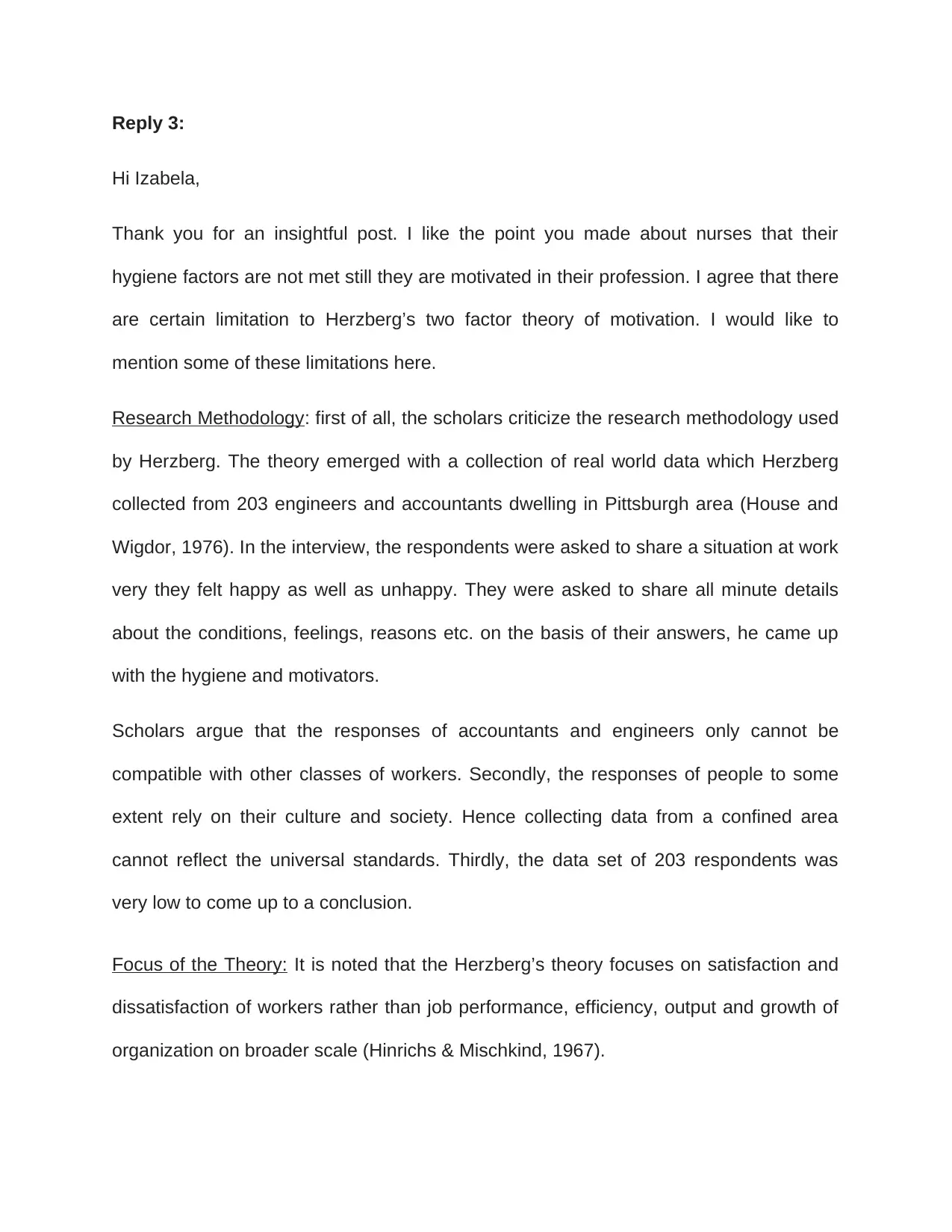
Reply 3:
Hi Izabela,
Thank you for an insightful post. I like the point you made about nurses that their
hygiene factors are not met still they are motivated in their profession. I agree that there
are certain limitation to Herzberg’s two factor theory of motivation. I would like to
mention some of these limitations here.
Research Methodology: first of all, the scholars criticize the research methodology used
by Herzberg. The theory emerged with a collection of real world data which Herzberg
collected from 203 engineers and accountants dwelling in Pittsburgh area (House and
Wigdor, 1976). In the interview, the respondents were asked to share a situation at work
very they felt happy as well as unhappy. They were asked to share all minute details
about the conditions, feelings, reasons etc. on the basis of their answers, he came up
with the hygiene and motivators.
Scholars argue that the responses of accountants and engineers only cannot be
compatible with other classes of workers. Secondly, the responses of people to some
extent rely on their culture and society. Hence collecting data from a confined area
cannot reflect the universal standards. Thirdly, the data set of 203 respondents was
very low to come up to a conclusion.
Focus of the Theory: It is noted that the Herzberg’s theory focuses on satisfaction and
dissatisfaction of workers rather than job performance, efficiency, output and growth of
organization on broader scale (Hinrichs & Mischkind, 1967).
Hi Izabela,
Thank you for an insightful post. I like the point you made about nurses that their
hygiene factors are not met still they are motivated in their profession. I agree that there
are certain limitation to Herzberg’s two factor theory of motivation. I would like to
mention some of these limitations here.
Research Methodology: first of all, the scholars criticize the research methodology used
by Herzberg. The theory emerged with a collection of real world data which Herzberg
collected from 203 engineers and accountants dwelling in Pittsburgh area (House and
Wigdor, 1976). In the interview, the respondents were asked to share a situation at work
very they felt happy as well as unhappy. They were asked to share all minute details
about the conditions, feelings, reasons etc. on the basis of their answers, he came up
with the hygiene and motivators.
Scholars argue that the responses of accountants and engineers only cannot be
compatible with other classes of workers. Secondly, the responses of people to some
extent rely on their culture and society. Hence collecting data from a confined area
cannot reflect the universal standards. Thirdly, the data set of 203 respondents was
very low to come up to a conclusion.
Focus of the Theory: It is noted that the Herzberg’s theory focuses on satisfaction and
dissatisfaction of workers rather than job performance, efficiency, output and growth of
organization on broader scale (Hinrichs & Mischkind, 1967).
Secure Best Marks with AI Grader
Need help grading? Try our AI Grader for instant feedback on your assignments.
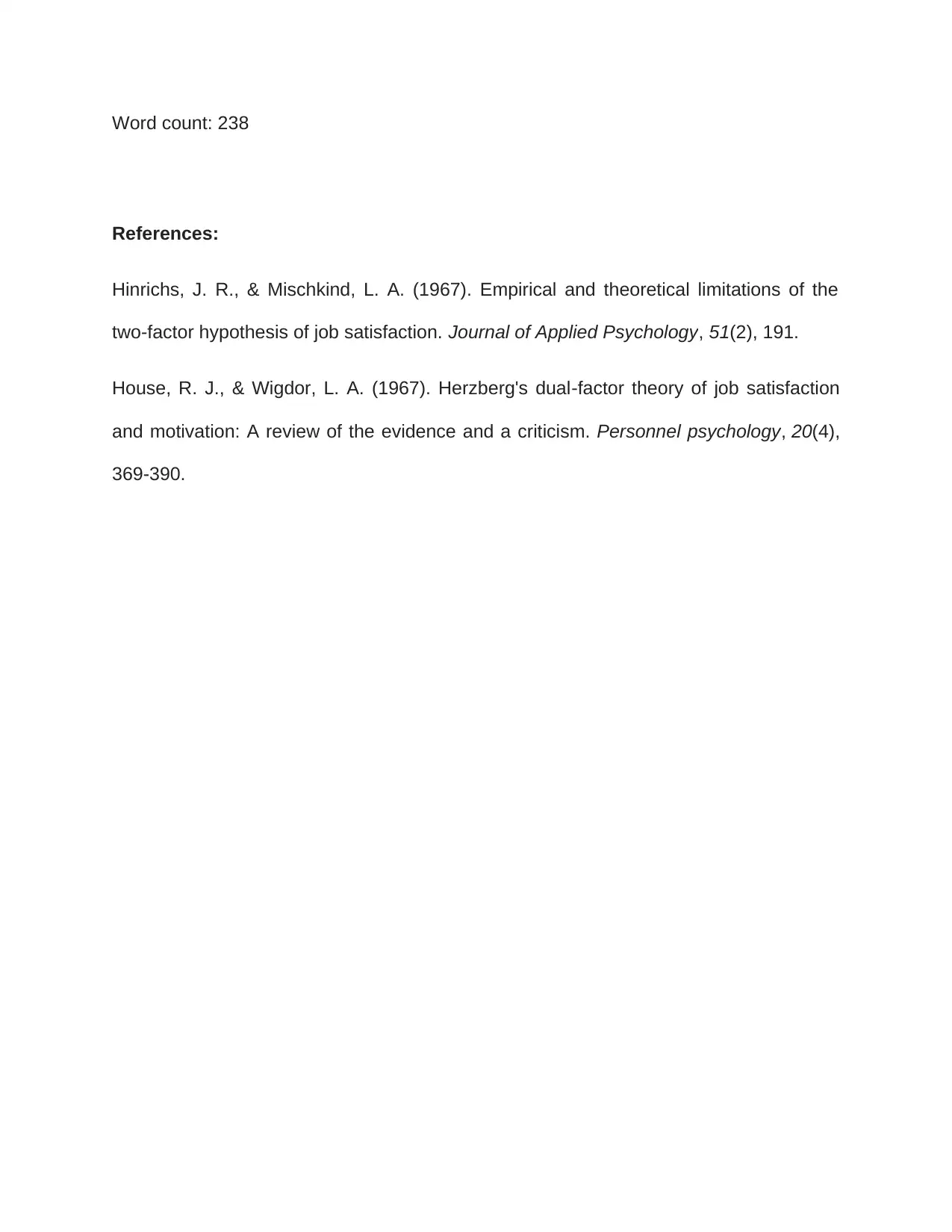
Word count: 238
References:
Hinrichs, J. R., & Mischkind, L. A. (1967). Empirical and theoretical limitations of the
two-factor hypothesis of job satisfaction. Journal of Applied Psychology, 51(2), 191.
House, R. J., & Wigdor, L. A. (1967). Herzberg's dual‐factor theory of job satisfaction
and motivation: A review of the evidence and a criticism. Personnel psychology, 20(4),
369-390.
References:
Hinrichs, J. R., & Mischkind, L. A. (1967). Empirical and theoretical limitations of the
two-factor hypothesis of job satisfaction. Journal of Applied Psychology, 51(2), 191.
House, R. J., & Wigdor, L. A. (1967). Herzberg's dual‐factor theory of job satisfaction
and motivation: A review of the evidence and a criticism. Personnel psychology, 20(4),
369-390.
1 out of 11
Related Documents
Your All-in-One AI-Powered Toolkit for Academic Success.
+13062052269
info@desklib.com
Available 24*7 on WhatsApp / Email
![[object Object]](/_next/static/media/star-bottom.7253800d.svg)
Unlock your academic potential
© 2024 | Zucol Services PVT LTD | All rights reserved.





